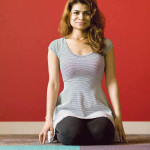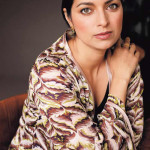Porcelain In The Veins
She strides into the Villeroy & Boch store in Mumbai, and becomes part of the fine bone china displays that line the shelves. She is one in spirit, posture and colour, reflecting the blues, greens and brilliant oranges that are splashed in harmony on the bone china white. Her white jacket is the perfect foil for her colourful scarf that mirrors the brightness around. She exudes energy, all six feet of her, and she loves to talk. About the brand that her family has owned for 265 years, about bone china, about beautiful tablesettings, about colours, patterns, passion…. She is passionate so that sometimes she feels like “there is porcelain running through my veins….”
On a flying visit from Carmel, California, where Isabelle von Boch lives, via Germany, on this her first morning ever in Mumbai, she says, “I am totally passionate about the product and that’s what stimulates me. All the people who work for Villeroy & Boch have a bond. Which is why I feel at home wherever I go….we speak the same language, we have the same culture….you can go to Mumbai in our store, you can go to Guatemala, the people are like a big family.” Just as well, since she travels at least 100 days a year, through the US, Canada, Central America, Australia and now to India as spokesperson for the brand – in English, French, Spanish and her native German.
While Villeroy & Boch essentially stands for a “relaxed Continental casual-yet-elegant or elegant-yet-casual lifestyle”, she is convinced that the products are a perfect fit for India. “The Indian population I think is wanting to interplay this European tradition that has been there for hundreds of years into their own traditions so Villeroy & Boch does very well in assimilating to this market by speaking to the emotion of people, to the emotion of colour; we have products that India loves, we have designs that India loves we also have products that are inspired by India, we have the Samarkand collection which has the paisley that reminds you of Kashmir….this is not a rational product, it is an emotional product and Indians respond to it because they are drawn to the beauty, drawn to the prestige of the brand,” she says all in one breath as she is wont to do.
Coming from a family of seven children, they were all intimately connected to dinnerware even as they were growing up. “There has always been the design gene in my family, my father had it, my mother painted her own dinnerware and had it fired; we always went to the factory, we painted, we drew, we designed tiles but I was so intimidated by the design gene that I decided to do something completely different, so I don’t paint but I talk.” And so she became the spokesperson for the brand, handling dinnerware like an artist would, mixing, matching, creating a zillion looks and combinations, just like that. “I am a gemmologist and used to have a gemstone business and have always had an eye for colour. I could discern whether a ruby comes from Ceylon (Sri Lanka) or India and the garnet from which mine in Africa, just by the colour. I still have a good porcelain eye; I love mixing and matching.”
Her family’s design gene goes back a long-long way. Some of the designs still in use today, albeit in a contemporary way, have been created as drawings by her forefathers. Her sister, Helen, has designed famous products that are displayed in the Museum of Modern Art in the US. And then there is the famous connection that the family has with Impressionist master, Van Gogh. “My aunt Anna Boch, a very accomplished impressionist painter was friends with Van Gogh. And her brother Eugene Boch as well. There is a painting by Van Gogh in the museum in Paris that is a portrait of my uncle. His sister bought two paintings of Van Gogh and the anecdote is that at that time in Paris no artists wanted to hang paintings with those done by ‘the crazy guy who painted the sunflowers’ (which went for 50 million dollars some years ago). But my uncle and aunt were friends with him and there is a correspondence between Eugene and Van Gogh, all in French, where he says that I am working on a new sketch, which in fact turned out to be Starry Night. My uncle and aunt were art collectors and supported the arts and bought paintings by Picasso, Miro and Matisse and knew all these people. When my uncle died he looked at the painting the whole time because Van Gogh had said that he had wanted to paint ‘a poet who had sensibility and sensitivity.’”
Even before the family’s connection with artists, existed the connection with the royal houses of Europe – Bavaria, Monaco, Holland, Spain, for which they created ‘wash sets’ in the late 1800s, since there was no running water. Besides, the last five Popes have all been using Villeroy & Boch. Why doesn’t the Vatican recycle, she asked herself once. Because each Pope has his own coat of arms which had to be designed exclusively. She also catches herself wondering about where the ‘most opulent and beautiful dinner set’ ordered by India’s former Prime Minister Indira Gandhi, could possibly be today….
Her mission has been to make bone china accessible to people. She is very clear that bone china which consists of bone ash is quite the strongest material around for dinnerware. Bone china cups can be made so fine as to be almost translucent, compared to porcelain, for this reason. She has her arithmetic squarely in place: “You could invest 1000 dollars in a product that breaks and chips and grazes so that at the end of the year you have nothing left and you have to reinvest. If you invest in the highest quality of porcelain that does not break and chip, and that lasts for 30 years, if you divide it, it costs you pennies,” she maintains, firmly. “Don’t put it on a pedestal, don’t be afraid of it.”
She does not believe in storing the best porcelain but rather in using it every day, deriving pleasure from it daily. Beware of the ‘china syndrome’ she warns, to hoarders of fine china. “Does your china own you, or do you own your china?” If you are expecting the Villeroy & Boch collection to be only embellished with silver and gold, like traditional porcelain, you will be pleasantly surprised. For here you have bone china in trendy contemporary shapes, sizes, fresh colours and bright designs. Not what you expected about bone china at all. “This company is 265 years old and yet our youngest products are 10 years old and have pushed us into the 21st century. We have been in the business for so long and are still close to the market. We are relevant in 125 countries – because we can contribute to how people live by leading them and also by listening to them.” The brand encourages ‘open stock’ which allows you to choose what you want, to mix and match and express your own individual style. Your table need not look like anyone else’s, ever!
Porcelain and family mean so much to her that she confesses: “I actually took my mother’s dinnerware that she had commissioned, I took it from Germany when she died, I didn’t ask, I took it and carried it to the States; because it was a memory. You see dinnerware creates memories. It is more than plates, it is socialising; it is communicating.” In the States, she says, people never sit down; the art of dining is lost. She is turning people onto a whole lifestyle where they can choose…. “Am I contemporary? Am I a country? Am I modern…classic? There is no china police, make decisions with your gut. Walk around, the patterns will speak to you,” she advises.
She loves to dance, read and listen to music, since she travels so much. The lady who once professed to being ‘the worst cook in the world’ is today happy that her children have voted her ‘not the worst cook’ anymore. “Chefs like a canvas that they can paint on so with my food, I was thinking that patterns and colours will camouflage that my cooking is not so great. But I have changed. I can serve on white plates now…. The visual is very important, you eat with your eyes….” Her husband is a vegan and she is vegan at home and a ‘flexitarian’ when she travels. “It is not a philosophy, I just feel good if I eat good food and take very good care of myself….”
She shows off, with understandable pride, images of ‘The Abbey’ in Mettlach, Germany, which is the family mansion where five of her siblings were born and which today is the headquarters of the company. The tower at the back is 1000 years old and the children spent many happy hours there. Today, the brand creates top-quality dinner services, cutlery and crystal ware which is created stronger than usual (“Why should someone drinking water or fruit juice, drink in ugly glasses?” she asks) as well as ceramic bathroom and wellness collections. “We have revolutionised the idea of the bathroom. We were the first in 1975 to bring out a blue collection which made the bathroom pretty and made it a part of the home, not to be hidden away, anymore.”
Didn’t she say already? Villeroy & Boch creates living spaces and offers a lifestyle – not just plates and bowls. Though we love those as well….
Related posts from Verve:
Verve Trending
Sorry. No data so far.
us on Facebook to stay updated with the latest trends





